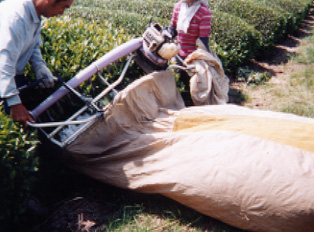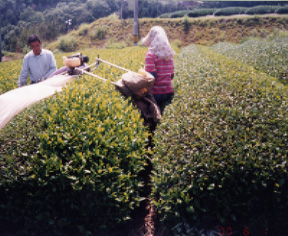| In 1981, about the same time Eleanor and I were starting to harvest
wild sea vegetables on the Mendocino County coast, Fumiyoshi Iwata and
his wife began an organic green tea garden on unpolluted land in Tsukigase
Village, Nara Prefecture, Japan.
Iwata-san is from a traditional tea-growing family. He and his wife were responding to Japanese demand for organic green tea. According to Iwata-san, about twenty kinds of agricultural chemicals are applied thirteen or fourteen times a year to commercial green tea bushes. Also, chemical fertilizer and herbicide are used on commercial green tea plantations. |
 |
 with the harvesting machine, trimming first one side of the hedge, then the other, filling the bag with fresh crop, always working together. |
Like Eleanor and I, the Iwatas also were seeking a lifestyle more in
harmony with community and nature. Tsukigase Village is an ancient
tea-growing village famous for its plum blossoms in the spring. The
Iwatas are intimate with their plants and with the villagers.
Working entirely without agricultural chemicals, the Iwatas apply oil cakes, oyster shells, and other organic fertilizer to the tea plants. Herring fertilizer adds sweetness to the tea. Iwata-san says that each year's crop has a subtly different taste. It is said that if the tea grown in Kagoshima and Shizuoka is sweet, then the Tsukigase crop, which matures later, also will be sweet that year. The annual variation in tea taste affects tea plants all over Japan in a similar way. |
| The Iwatas wander their tea garden, plucking insects from the leaves.
Over the years, several plant pests have attacked the Tsukigase Health
Tea Garden. About ten years ago, a caterpillar infestatation was
too large for them to handle alone. Many villagers turned out and
went through the tea bushes plucking off hairy caterpillars. "Our
tea garden wouldn't exist without their help," said Iwata-san.
Tea is a camellia plant (Camellia sinesis). The world's most popular drink after water, the healing virtues of tea are fabled in folk lore and documented by modern science. Many American healers recommend daily drinking of green tea as an antioxidant to prevent cancer. We are delighted to be able to offer you Tsukigase Health Green Tea, the first pick of new spring leaf, which has the strongest healing virtues of all types of tea. In the summer of 2000, our friend Misako Watabe visited the Iwatas in their Tsukigase Health Tea Garden. Here are some photos she took. |


|

